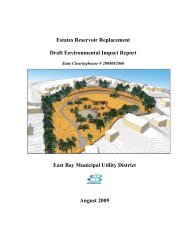Create successful ePaper yourself
Turn your PDF publications into a flip-book with our unique Google optimized e-Paper software.
Table 1Definitions of Acoustical Terms Used in this ReportTermDecibel, dBSound Pressure LevelDefinitionsA unit describing, the amplitude of sound, equal to 20 times the logarithm to the base10 of the ratio of the pressure of the sound measured to the reference pressure. Thereference pressure for air is 20.Sound pressure is the sound force per unit area, usually expressed in micro Pascals (or20 micro Newtons per square meter), where 1 Pascal is the pressure resulting from aforce of 1 Newton exerted over an area of 1 square meter. The sound pressure level isexpressed in decibels as 20 times the logarithm to the base 10 of the ratio between thepressures exerted by the sound to a reference sound pressure (e.g., 20 micro Pascals).Sound pressure level is the quantity that is directly measured by a sound level meter.Frequency, HzA-Weighted SoundLevel, dBAThe number of complete pressure fluctuations per second above <strong>and</strong> belowatmospheric pressure. Normal human hearing is between 20 Hz <strong>and</strong> 20,000 Hz.Infrasonic sound are below 20 Hz <strong>and</strong> Ultrasonic sounds are above 20,000 Hz.The sound pressure level in decibels as measured on a sound level meter using the A-weighting filter network. The A-weighting filter de-emphasizes the very low <strong>and</strong>very high frequency components of the sound in a manner similar to the frequencyresponse of the human ear <strong>and</strong> correlates well with subjective reactions to noise.Equivalent <strong>Noise</strong> Level,L eqL max , L minL 01 , L 10 , L 50 , L 90Day/Night <strong>Noise</strong> Level,L dn or DNLCommunity <strong>Noise</strong>Equivalent Level, CNELThe average A-weighted noise level during the measurement period.The maximum <strong>and</strong> minimum A-weighted noise level during the measurement period.The A-weighted noise levels that are exceeded 1%, 10%, 50%, <strong>and</strong> 90% of the timeduring the measurement period.The average A-weighted noise level during a 24-hour day, obtained after addition of10 decibels to levels measured in the night between 10:00 pm <strong>and</strong> 7:00 am.The average A-weighted noise level during a 24-hour day, obtained after addition of 5decibels in the evening from 7:00 pm to 10:00 pm <strong>and</strong> after addition of 10 decibels tosound levels measured in the night between 10:00 pm <strong>and</strong> 7:00 am.Ambient <strong>Noise</strong> LevelThe composite of noise from all sources near <strong>and</strong> far. The normal or existing level ofenvironmental noise at a given location.IntrusiveThat noise which intrudes over <strong>and</strong> above the existing ambient noise at a givenlocation. The relative intrusiveness of a sound depends upon its amplitude, duration,frequency, <strong>and</strong> time of occurrence <strong>and</strong> tonal or informational content as well as theprevailing ambient noise level.Source: H<strong>and</strong>book of Acoustical Measurements <strong>and</strong> <strong>Noise</strong> Control, Harris, 19984

















